June 3, 2025 | 01:15 GMT +7
June 3, 2025 | 01:15 GMT +7
Hotline: 0913.378.918
June 3, 2025 | 01:15 GMT +7
Hotline: 0913.378.918
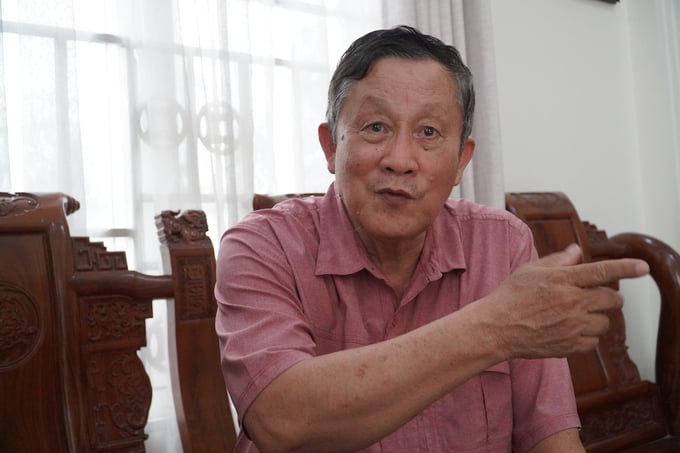
Prof. Dr. Bui Chi Buu, former Director of the Cuu Long Delta Rice Research Institute, discussing the development history of rice in Vietnam. Photo: Kim Anh.
According to Prof. Dr. Bui Chi Buu, former Director of the Cuu Long Delta Rice Institute, the development journey of rice in Western Vietnam began between the years 1921 and 1924. This was the golden age for Vietnam's rice exports, which peaked at a million tons annually. By 1939, the amount of Vietnamese annual rice exports has climbed to two million tons.
However, the famine in 1945 caused Vietnam's rice exports to gradually decrease over the years. Most notably, the amount of rice export fell to only 0.52 million tons by 1954. By 1968, Vietnam ceased its exporting activities to become a rice importing country. Additionally, Vietnam had to import two million tons of food in 1980.
According to Mr. Buu, who has experienced the extended period of food shortages that preceded the current rice revolution, rice farmers in the past primarily cultivated traditional varieties with a low yield at only two tons per hectare.
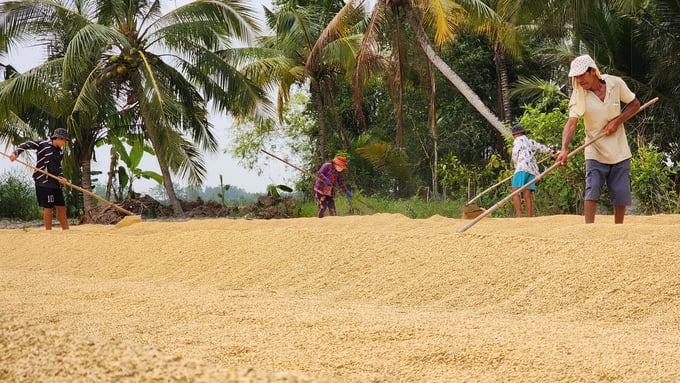
Rice farming is a historical and traditional profession that provides stable and sustainable income for farmers in Western Vietnam. Photo: Kim Anh.
The Cuu Long Delta Rice Research Institute was founded in 1977. At the time, the Mekong Delta predominantly imported rice varieties from the International Rice Research Institute (IRRI) for large-scale production. Notable rice varieties during this time period include the IR36, IR19660 and TN73-2. However, these rice varieties have a lengthy cultivation period, which can last to at least 120 days.
“During the early years, my colleagues and I traveled from Ho Chi Minh to Can Tho city for our employment at the Cuu Long Delta Rice Research Institute. I spent three years surveying and collecting nearly 2,600 rice seed samples across the country. In addition, I searched for wild rice varieties in the Dong Thap Muoi region with the aim of creating a parental generation for future breeding", Prof. Dr. Bui Chi Buu shared on his experience with rice breeding.
The rice fields in Western Vietnam suffered from a severe infestation of brown planthopper at the time. As a result, Vietnamese scientists were determined to research and create new rice varieties.
“We had a strategy of planting rice before and after the flood. That means the summer-autumn crops, which were planted between April and May, could be harvested in August. Subsequently, farmers would sow wherever the flood waters recede. As a result, the sowing areas were inconsistent, and we had to reduce the rice cultivation period from 120 to 90 or 100 days", Mr. Buu added.
According to Professor Buu, the Cuu Long Delta Rice Research Institute crossbred at a rate of 150 to 200 hybrid combinations per year in order to find the most satisfactory variety. New rice varieties are subject to at least two years of testing and an additional eight years of mass production.
Scientists concluded that the standards for a rice variety include a 90-day cultivation period, long grains that meets the requirements of the export market, softness and resistance to brown planthoppers. All of these standards must be followed goals in order to produce a high-quality seed.
Using a set of materials donated by India, Vietnamese scientists successfully cross-bred and produced the first short-term rice variety, OM80. Subsequently, other short-term high-yield rice varieties bred by the Cuu Long Delta Rice Research Institute have been put into effective production, including OM269, OM1490, OM4900, OM2517, and AS996.
In addition, the Cuu Long Delta Rice Research Institute received support from multiple international organizations to implement large-scale programs which last five to six years, with the help of the IRRI. These programs helps to find high-yield rice varieties that can withstand salinity, flooding, drought, and phosphorus deficiency in acidic soils. These rice varieties have become buffer materials for future research and breeding.
Manual labor was gradually and widely replaced by rapid mechanization in rice production in the following years. These signficant changes brought Vietnam back to the rice export market in 1989 with mainly hard and low-value rice.
The export market has shifted markedly since 1995, resulting in higher standards for Vietnamese rice. The market began favoring white rice with soft grains over 7mm in length. As a result, scientific research activities at the Cuu Long Delta Rice Research Institute changed direction.
The research efforts have brought remarkable success for Vietnam's rice production. Namely, the country's rice production increased rapidly, reaching 5 to 6 million tons in 2000, 20 million tons in from 2005 to 2006, and 24 to 25 million tons presently.
According to Prof. Dr. Bui Chi Buu, rice production has the lowest investment level in exchange for the most stable and sustainable profits. On the other hand, rice serves to strengthen Vietnam's international political stance. As a result, extensive investments in scientific research is the foundation for the development of the rice industry.
“It took us five years to increase the length of a rice grain from 6.6 - 6.7mm to 7mm and nearly ten years to peel and grind each rice grain, testing and maintaining the amylose content at 20%. It was an extremely difficult stage," Prof. Dr. Bui Chi Buu shared.
Over 120 years ago, the French colonists conducted a excavation on the 40-kilometer Xa No canal. This canal connects Can Tho river (from Vam Xang, Phong Dien district) with the Cai Lon river (Cai Tu canal), both of which flow into the West Sea. As a result, a unique waterway was created to transport rice for consumption and export throughout Western Vietnam.

Xa No canal - The unique waterway which allows the transportation of rice for consumption and export throughout Western Vietnam over 120 years ago. The canal has since become the lifeline of locals in Hau Giang province. Photo: Kim Anh.
According to Prof. Dr. Bui Chi Buu, Xa No is Khmer for Soc Snor, which means home to the Egyptian riverhemps. Local farmers were initially astonished by the sight of a modern canal excavator. After the excavation, Xa No canal is further divided into small cross-sections, with a small canal every 500 meters and a large one every 1,000 meters. Xa No canal flows in parallel with the Cai San canal system, forming a series of canals: One Thousand, Seven Thousand, Fourteen Thousand, etc. Xa No canal becomes a lifeline for the local inhabitants, serving as rice's only transportation path to Saigon port.
Prof. Dr. Bui Chi Buu recalled: "Rice is transported using sampans. Sampans were frequently marked so that farmers can distinguish the origin of each vehicle. Farm owners in Bac Lieu and Soc Trang transported rice from the Tien river to the Mang Thit river through the Cho Gao canal in Tien Giang province to the Vam Co river, and finally arriving at the port of Saigon."
After the liberation of the South to unify the country in 1975, the irrigation system in the region is continuously enhanced. The government has dug vertical and horizontal canals with sluices and locks to prevent salt water. As a result, fresh water from the Hau River is delivered inland to serve rice production.
However, saltwater intrusion has occured since 2010 as a result of climate change, with approximately 60,000 hectares of production area affected. Saltwater intrusion was the most severe between 2015 and 2016, with 250,000 to 260,000 hectares of rice production area lost. The dangerous saltwater intrusion belt is slowly shrinking and the alluvium content is depleted. The construction of hydroelectric dams in China has caused saltwater intrusion to grow stronger every dry season.
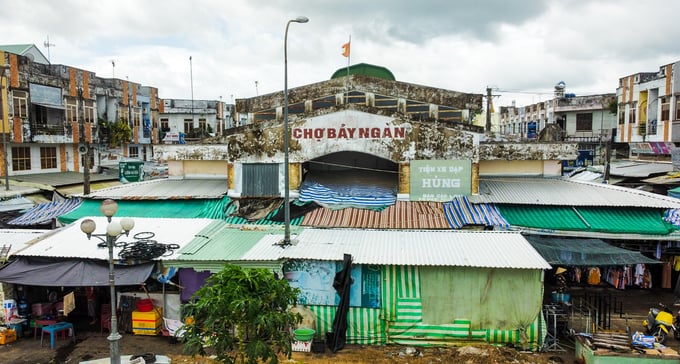
Bay Ngan market in Chau Thanh A district, Hau Giang province is often associated with the development history of Xa No canal. It was originally a large rice storage established by the French colonists in Southern Vietnam. Photo: Kim Anh.
Prof. Dr. Bui Chi Buu highlighted the three most important factors that facilitate the development of the rice industry, which are policy, seeds and irrigation. Mr. Buu emphasized that irrigation is the leading factor in determining the success of a crop. An excellent seed source can still be hindered by a poor irrigation system.
The Ministry of Agriculture and Rural Development recently invested heavily in the irrigation system of the Mekong Delta. Most notably, the construction of the Cai Lon - Cai Be irrigation system helps the West Hau River region prevent salinity and solve traffic problems. According to preliminary calculation data provided by Prof. Dr. Bui Chi Buu, investment capital from the Ministry of Agriculture and Rural Development for irrigation in agricultural and rice production accounts for approximately 70%.
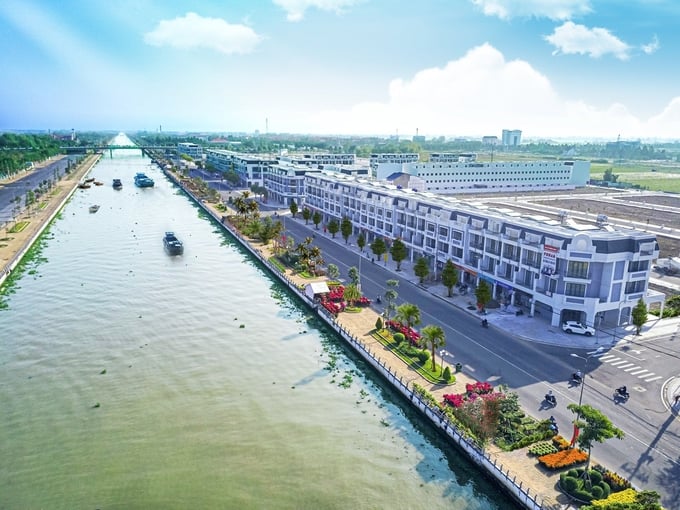
Present day Xa No canal has become a tourist attraction in addition to serving the circulation and transporting goods within Hau Giang province. Photo: Kim Anh.
"Vietnam's rice industry is extremely promising. Despite countless difficulties and challenges, we have achieved multiple successes", concluded Prof. Dr. Bui Chi Buu.
Translated by Nguyen Hai Long

(VAN) TTC AgriS and IFC signed a strategic partnership to develop a sustainable agricultural value chain, aiming to achieve the Net Zero target by 2035.

(VAN) Seafood by-products are opening a new path, combining green growth and technological innovation to enhance the industry's value.

(VAN) Mr. Nguyen Thanh Cong, Vice Chairman of the Son La Provincial People's Committee, reflects on Son La’s journey from barren hills to fruitful orchards after a decade of hard work.
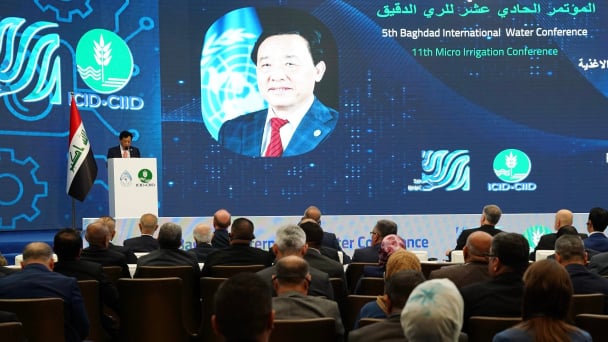
(VAN) FAO’s Director-General addresses the 5th Baghdad International Water Conference.
/2025/05/26/1716-4-nongnghiep-191706.jpg)
(VAN) Chain linkages, technological innovation, and raw material zoning are three strategic pillars for the coconut industry to strongly develop and elevate its position on the global agricultural map.
![Advanced mariculture – an inevitable trend: [4] Accompanied by scientists](https://t.ex-cdn.com/nongnghiepmoitruong.vn/608w/files/sohk/2025/05/13/1941-pgsts-vo-van-nha-140958_717.jpg)
(VAN) According to Assoc. Prof. Dr. Vo Van Nha, Director of the RIA III, the development of advanced offshore mariculture is no longer an option but an essential path for Vietnam’s fisheries sector.

(VAN) Vietnam is intensifying the development of mollusk farming areas that meet international standards, aiming for sustainable growth and enhancing its export position in the global seafood market.